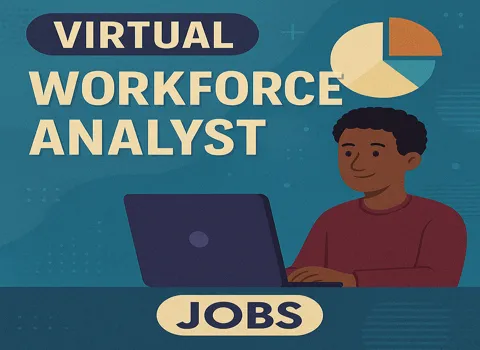Virtual Workforce Analyst
Description
Virtual Workforce Analyst
Introduction to the Opportunity
Are you ready to make an impact from anywhere? Join a dynamic, future-focused team that is shaping the way modern businesses operate through remote talent optimization. As a Virtual Workforce Analyst, you will play a critical role in monitoring, evaluating, and improving the performance of distributed teams. Your analytical insight will directly influence strategic decisions across departments, guiding workforce planning and enhancing overall productivity. In a world rapidly shifting toward remote-first environments, this is your opportunity to be at the forefront of transformation.
Why This Role Matters
The growth of remote workforces has transformed organizational operations, requiring fresh perspectives and data-driven solutions to optimize virtual performance. This role empowers you to bring those solutions to life. You’ll analyze workforce metrics, support capacity modeling, and partner with operational leaders to forecast trends and implement remote collaboration strategies that drive efficiency. This isn’t just an analytical job—it’s a gateway to shaping tomorrow’s work culture.
Key Responsibilities
Core Duties
- Interpret and present workforce data to identify performance trends across remote teams.
- Develop dashboards and KPIs that track team utilization, engagement, and attendance.
- Collaborate with department leaders to assess workforce capacity and recommend improvements.
- Utilize predictive modeling techniques to forecast staffing requirements and refine shift schedules.
- Identify workforce bottlenecks and design scalable solutions for virtual operations.
- Create insightful reports that empower executive leadership with actionable recommendations.
- Monitor compliance with remote work policies and suggest improvements based on metrics.
- Assist in developing standard operating procedures for workforce analytics and reporting.
Work Environment & Culture
We embrace a fully remote, results-driven culture where flexibility meets accountability. Here, you’ll be part of an inclusive team that thrives on innovation and collaboration. We promote autonomy without isolation—expect frequent virtual syncs, interactive brainstorming sessions, and strong peer-to-peer connections. Your insights won’t sit in silos; they’ll actively influence the way our workforce operates globally.
You’ll join an organization that respects your time and values your well-being. The remote work structure empowers you to balance professional performance with personal fulfillment, providing you with the space to grow, contribute, and feel connected, regardless of your location.
Tools & Technologies You’ll Use
Software and Platforms
- Workforce analytics platforms such as NICE, Verint, or Tableau
- Data visualization tools like Power BI or Looker
- Collaboration systems, including Slack, Microsoft Teams, and Zoom
- Advanced Excel modeling and Google Workspace
- SQL or Python for deeper data analysis and scripting
- HR systems like Workday or BambooHR for integrated insights
Qualifications and Skills
Required Experience
- 3+ years in workforce analytics, data analysis, or remote team performance roles
- Proven experience with remote data reporting and distributed team metrics
- Strong fluency in data modeling, forecasting, and visualization techniques
- Excellent communication skills for translating analytics into strategic insights
- Comfortable engaging across teams such as HR, Operations, and IT to align on goals
- Deep understanding of virtual workforce dynamics and performance barriers
- Meticulous attention to detail and a solutions-oriented mindset for improving processes
Exciting Benefits You’ll Enjoy
- Annual salary of $91,586—competitively benchmarked for remote roles
- Comprehensive health, dental, and vision insurance
- Flexible hours and a remote-first setup with global team exposure
- Paid time off plus mental wellness days
- Annual learning stipend for certifications, courses, and conferences
- Tech allowance to upgrade your remote work environment
- Career advancement paths in operations, analytics, or team leadership
- Virtual team retreats and performance celebrations
Career Growth & Impact
This isn’t just another analyst role. It’s a stepping stone to leadership in remote operations strategy. You’ll gain visibility with executives, contribute to high-impact projects, and influence future policies around workforce design. Whether you want to specialize in remote productivity, lead a global analytics team, or expand into virtual organizational strategy, the opportunity is here to craft your path.
We believe in elevating our people—those who bring curiosity, critical thinking, and the courage to challenge the norm. If you’ve been waiting for the chance to drive meaningful change from a remote setting, this is it.
Your Next Big Opportunity Awaits
Take charge of your future and shape the evolution of modern work. If you’re passionate about remote workforce optimization, data-driven decisions, and making a global impact, apply now and become the engine behind strategic growth in a virtual-first world!
Frequently asked questions (FAQs)
1. What does a typical day look like for a Virtual Workforce Analyst?
Every day brings a new puzzle. One morning, you might be building a dashboard that helps managers quickly visualize team capacity. Later, you might analyze remote attendance data and then participate in a brainstorming session about shift patterns. You end the day pulling together a story from all those numbers—what’s working, what needs to change, and what’ll make life smoother for the team tomorrow.
2. What’s the most interesting challenge in this job?
Finding the human story behind the metrics. Sometimes, it’s spotting a trend in late logins or a dip in team engagement before anyone else notices. On other days, it’s working with different departments to transform raw data into something leaders can actually use. The real win? When your insight sparks a change that helps teams work together more smoothly and actually enjoy the results.
3. How do you use data to improve remote team performance?
It starts with curiosity. You don’t just collect numbers—you look for patterns and ask what they mean in real life. Maybe you notice certain projects stall at the same point, or a team feels stretched too thin. By sharing these insights, you help teams adjust before problems escalate, turning analytics into actionable insights.
4. What tools do you lean on to make sense of it all?
It depends on the question. Some days, you’re diving into Tableau to build a visual story; other times, it’s a quick check in Power BI, or exporting data to Excel for deeper analysis. You might pull numbers from Slack or Zoom, run a script in Python, or tap into HR tools like Workday to round out the picture. The goal is to turn technology into clear, useful answers.
5. How does this job set you up for future growth?
You get a front-row seat to the future of work. By working across departments and testing new ideas, you’ll build skills in analytics, team strategy, and even tech implementation. You’ll see your recommendations shape real changes, gain exposure to leadership, and be ready to step into roles focused on operations, analytics, or even leading remote teams yourself.



